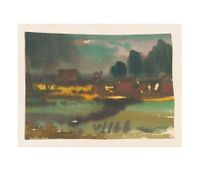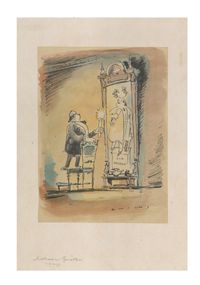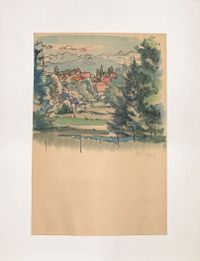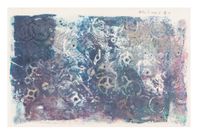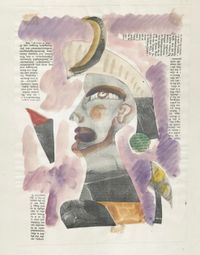Work
Hans Ohlms began drawing as a child. Gradually he perfected his skills and was talented in many ways. From sketches to oil paintings, from watercolors to linoleum prints, and he also mastered caricatures. In 1949 Ohlms took part in the collective exhibition of artists of the Bund Bildender Künstler Osnabrück in the Städtisches Museum Osnabrück. There he tried to bring together the creative approaches of European modernism with the skills of his training years. During this time Ohlms created commercial graphics, his own pictorial designs (e.g. landscape watercolors) and commissioned works - especially portraits. However, this period of his creative work also included the fact that he became dissatisfied with his pictorial achievements and, in phases of dejection, destroyed considerable parts of his work, which no longer convinced him artistically.
Ohlms felt more and more constricted by private commissions. Public commissions were therefore a welcome change for him, which he perceived as a new challenge that he consciously got involved with. Thus, he created many works in churches and schools - and as one of his main works, the over 6x 7 meter large mosaic in the chapel of the Nordhorn South Cemetery.
However, he only attained complete artistic freedom in old age and with the economic security provided by his retirement pay. This was the period he called his "true artistic creation". In his studio he created more than a thousand works during this period. Unhindered by guidelines and beyond all style definitions, he explored unseen pictorial worlds. In the process, he also created a variety of three-dimensional works. Relief pictures made of radio parts and scraps of fabric as well as small sculptures made of metal and wood date from this period. In terms of content, he thus made the fragility of the industrial world of Nordhorn his theme, anticipating the demise of the textile industry.
Despite his remarkable and multifaceted oeuvre, Hans Ohlms has almost been forgotten in the art world. However, a retrospective in Osnabrück in 1988 presented his work and finally created an awareness of his skills in the professional world as well as in the public.
The copyright for the works of Hans Ohlms remains with the Hans-Ohlms-Foundation.

